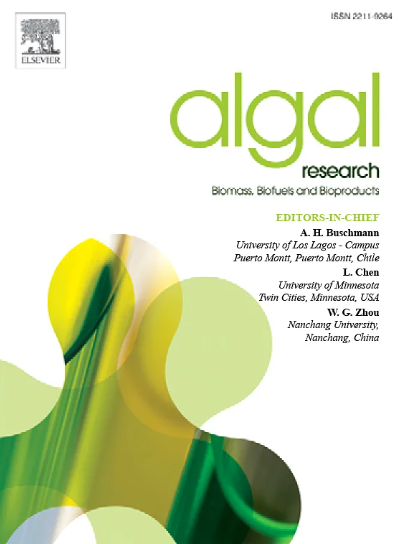Machine learning - based optimization of integrated extraction method for R-phycoerythrin from dry biomass of Gracilaria corticata
IF 4.6
2区 生物学
Q1 BIOTECHNOLOGY & APPLIED MICROBIOLOGY
Algal Research-Biomass Biofuels and Bioproducts
Pub Date : 2025-03-04
DOI:10.1016/j.algal.2025.103986
引用次数: 0
Abstract
Macroalgal biomass, a valuable source of bioactive compounds, is highly perishable in its wet form. Drying helps in the extension of its shelf life. However, conventional wisdom indicates that drying increases the mass transfer resistance, making extraction of biomolecules from dry biomass more difficult. The present study is aimed at developing the most suitable method for the primary extraction of R- Phycoerythrin (R-PE) from dry biomass of Gracilaria corticata. Practically, such reports are not available. Different extraction methods alone and their integration (in order to enhance the yield) are employed. A pre-soaking (12h) step of the dry biomass prior to extraction is found to significantly decrease the mass transfer resistance in all the primary extraction methods. Key extraction process parameters such as solid-liquid ratio (1:20, 1:30, and 1:40), extraction time (10, 20, and 30 min), and ultrasonication amplitude (20, 40, and 60 %) were standardized. The Box-Behnken Design (BBD) is employed to identify the configurations covering the entire range of the selected parameters of the integrated extraction method. This approach enabled optimization through a reduced number of experiments. Further, a machine learning model, the Gradient boosting model, is employed to predict the yield of R-PE for all possible combinations of extraction process parameters. Among all the methods employed, ‘ultrasound-assisted extraction + homogenization’ resulted in the highest yield of R-PE (1.23 mg/g dw) with an extraction efficiency of 87.8 %.
巨藻生物质是生物活性化合物的宝贵来源,但湿态生物质极易变质。干燥有助于延长其保质期。然而,传统观点认为,干燥会增加传质阻力,从而增加从干燥生物质中提取生物分子的难度。本研究旨在开发一种最合适的方法,用于从 Gracilaria corticata 的干燥生物质中初步提取 R- Phycoerythrin (R-PE)。实际上,目前还没有此类报告。我们采用了不同的单独提取方法和综合提取方法(以提高产量)。研究发现,在所有初级萃取方法中,萃取前对干生物质进行预浸泡(12 小时)可显著降低传质阻力。固液比(1:20、1:30 和 1:40)、萃取时间(10、20 和 30 分钟)和超声振幅(20、40 和 60%)等关键萃取工艺参数均已标准化。采用方框-贝肯设计法(BBD)确定综合萃取法所选参数整个范围内的配置。这种方法通过减少实验次数来实现优化。此外,还采用了机器学习模型(梯度提升模型)来预测所有可能的萃取工艺参数组合的 R-PE 产量。在所有采用的方法中,"超声辅助萃取 + 均质化 "的 R-PE 产量最高(1.23 毫克/克干重),萃取效率为 87.8%。
本文章由计算机程序翻译,如有差异,请以英文原文为准。
求助全文
约1分钟内获得全文
求助全文
来源期刊

Algal Research-Biomass Biofuels and Bioproducts
BIOTECHNOLOGY & APPLIED MICROBIOLOGY-
CiteScore
9.40
自引率
7.80%
发文量
332
期刊介绍:
Algal Research is an international phycology journal covering all areas of emerging technologies in algae biology, biomass production, cultivation, harvesting, extraction, bioproducts, biorefinery, engineering, and econometrics. Algae is defined to include cyanobacteria, microalgae, and protists and symbionts of interest in biotechnology. The journal publishes original research and reviews for the following scope: algal biology, including but not exclusive to: phylogeny, biodiversity, molecular traits, metabolic regulation, and genetic engineering, algal cultivation, e.g. phototrophic systems, heterotrophic systems, and mixotrophic systems, algal harvesting and extraction systems, biotechnology to convert algal biomass and components into biofuels and bioproducts, e.g., nutraceuticals, pharmaceuticals, animal feed, plastics, etc. algal products and their economic assessment
 求助内容:
求助内容: 应助结果提醒方式:
应助结果提醒方式:


